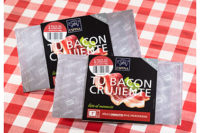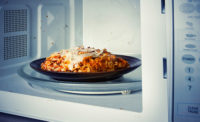
Over the last decade, microwaveable packaging has gained new momentum in retail foods. And it’s not just the demand for convenience driving this trend. The economic downturn has caused consumers to eat out less frequently, but meanwhile, the desire for quality, healthy, chef-inspired meals has continued to increase.
Convenient, ready-to-eat refrigerated or frozen food products are meeting this market demand. Microwaveable meals replace labor-intensive homemade meals and can provide quality that resembles restaurant fare. Product formulations, microwave packaging technology and packaging design continue to evolve so that consumers can enjoy quick-prepared foods with the same taste profile and texture as conventional cooking.
Some very popular products include hearty prepared meat entrees for the family that provide three or four servings per package. Single-serve, on-the-go meal options have also gained market share. Convenience means that single-serve meal options can often be eaten directly from the container — using a bowl or an on-the-go cup — with insulated foam labels that protect the consumer from the heated container.
Packaging for chilled foods
Packaging for refrigerated, ready-to-eat food products has specific requirements. Most of these products use modified-atmosphere packaging (MAP) techniques to extend their shelf life. MAP introduces a specific gas mixture that prevents the growth of aerobic spoilage microorganisms. Packages for this application must have barrier properties to ensure containment of the gas mixture. Most of these products are also heated within the containers so packages must be able to withstand heat without becoming deformed.
Advances in processing and packaging help extend shelf life and offer new product opportunities. High-pressure processing is a post-packaging pasteurization procedure without heat that can improve product safety and extends the shelf life of the product without affecting taste, texture, appearance or nutritional value.
The package can provide convenience and ensure food safety, but heating issues are still challenging. New technology has been developed by a Dutch company whose package design for multi-component meals allows simultaneous microwave heating of chilled foods that require high heat and foods that do not (such as salads) in the same tray. Several meal components — each in a separate individual package — can be reheated simultaneously, and each meal component will receive the optimal amount of energy. The technology works by blocking energy completely or partly depending on the meal component requirements (physical shielding principle). This functionality is enabled by a thin metal sheet that is integrated inside the packaging walls.
Steamer packaging
Frozen foods are the largest application for microwave packaging. The development of steam-assisted microwave preparation has fueled growth in this food category. Microwave oven heating can generate steam to more rapidly heat a product in a closed environment. Containing the steam allows it to function as a complementary heating medium to the microwave energy. Rapid heating enables flavor, texture and nutrient value to be retained.
Microwave packages for frozen prepared foods have been engineered to take advantage of steam-enhanced cooking. Frozen prepared foods can be packaged in heat-resistant, flexible pouches with areas of weakness to permit splitting of the pouch. This allows the excess steam to self vent and the contents to be easily dispensed.
Frozen entrees are also offered in microwave steamer packages consisting of a heat-resistant plastic bowl that contains a sauce and a basket insert that contains a meat. During microwave heating, the sauce is heated first and the steam generated helps heat the meat component. Both are mixed together prior to consumption.
Susceptor packaging
Another packaging development for frozen food application is the use of microwave susceptors. Microwave susceptor packaging provides browning and crisping by high-temperature Maillard reaction to duplicate conventional oven cooking. This technology is based on light deposition of microwave active metal on thermally stable substrate (like PET) and laminated to a back stock that provides rigidity. Susceptor packaging may be used in conjunction with product reformulation such as the addition of a browning agent. Products such as pizza, meat pies, French fries and hash browns can be heated with a crispy texture.
Recent techniques involve intricate design patterns to provide special effects and added convenience. Susceptors have been designed to focus the high heat in specific patterns to create grill marks for gourmet sandwiches. The susceptor can also be designed into “quilts” that expand when exposed to microwave energy. The inflated cells allow moisture to evaporate from the food surface and maximize browning and crisping. In a pouch format, consumers can eat directly from the package because the inflated cells protect the consumer from the hot food.
To enhance the microwave-heated eating experience, flavor additives can be added to the plastic packaging that replicate the aromas emanating from conventional food cooking. When the package is heating in the microwave, the aromas are released into the air, resulting in increased aroma during cooking and eating. Food-grade flavors such as tomato herb, roasted garlic, maple brown sugar, teriyaki and butter-roasted chicken have been incorporated in thermoformed packaging at the time of molding.
Improvements in package structures are driving new product introductions. These packaging innovations enable foods to be heated and served in their packaging and overcome limitations of microwave ovens to achieve taste and textures that are closer to foods cooked in conventional ovens or stovetops. Thanks to these technological advances, the future is bright for microwaveable, ready-to-eat products.
Carol Zweep (CPP, M.Sc.) is Manager of Packaging and Nutrition Labelling Services at the Guelph Food Technology Centre (www.gftc.ca) in Guelph, Ontario. She can be reached at czweep@gftc.ca. GFTC provides services to the food and beverage processing industry.



Report Abusive Comment